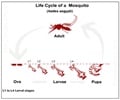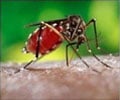Mosquito species that carry infectious diseases like Zika and dengue can now be easily identified by a rapid, cost-effective tool, says study.
- Researchers have developed a new, rapid, cost-effective and easy-to-use diagnostic tool that uses a smartphone camera, a small 3D-printed box and a simple chemical test to show whether a dead mosquito belongs to the Aedes aegypti species –the one that carries the Zika or yellow fever virus
- The tool can also effectively detect the Wolbachia bacterial strain that is widely studied for possible properties to block transmission of viruses like chikungunya, dengue, and Zika.
"Many of these diseases are spreading in areas where they weren't common before," said Sanchita Bhadra, a research associate in the Department of Molecular Biosciences and first author on the paper. "Having surveillance is important in conjunction with any kind of outbreak, and this method allows a rapid test in the field."
Aedes aegypti is a mosquito species that infects about 100 million people worldwide with illnesses like dengue, Zika, chikungunya or yellow fever. These mosquito-transmitted viruses initially affected only people in the tropics, but have grown to become a widespread health menace due to increased global movement and insecticide resistance. The species is the reason mosquito-borne diseases have tripled in the United States since 2004.
In order to curb viral transmission, in countries around the world and in 20 U.S. states where the Aedes aegypti mosquito is found, the researchers working in public health agencies have used a strategy to infect the disease-causing mosquitoes with a biopesticide called Wolbachia, a type of bacteria that keeps mosquitoes from spreading diseases.
However, Aedes aegypti, do not show any visual signs of having Wolbachia infection. Besides, current diagnostic tests are hard to read, expensive and logistically cumbersome.
Hence, Sanchita Bhadra of the University of Texas in Austin, and her colleagues developed a probe that along with a smartphone camera can test the nuclear material of Wolbachia, in addition to finding out the mosquito species type. The tool represents a significant step forward to test the effectiveness of Wolbachia.
The probes termed "OSD probes" are based on fundamentals of nucleic acid chemistry. The researchers applied the probes to accurately read "LAMP assays" (a relatively simple nucleic acid detection test). The OSD probe will produce a visible signal only if it binds to the target LAMP DNA; in the absence of specific target DNA, no signal is generated.
The new design of the tool yields an accurate Yes/No visual readout on the smartphone and prevents a very common drawback of LAMP - false positive results. Moreover, when using the one-pot assay, the nucleic acid does not need to be removed and purified to analyze the crudely softened individual or pooled mosquitoes and renders the test simple and one that can be done anywhere.
Study
Scientists conducted a blinded test of 90 field-caught mosquitoes- The cellphone assay specificity was 98 percent and sensitivity was 97 percent in identifying Ae. aegypti mosquitoes, even when the samples were stored at 37 degrees Celsius without a desiccant for 3 weeks.
- The test also readily identified the Wolbachia strain in field-collected mosquitoes without generating any false positive signals
The researchers conclude: "We are currently automating the assays and workflow on low-cost paper and plastic devices that will not only further streamline diagnostic application but will also provide sealed chambers for biohazard and aerosol containment for macerating mosquitoes. Our sample preparation and workflow not only simplify the application of molecular diagnostics for surveillance but also reduce cost by eliminating the need for nucleic acid extraction and complex instruments for assay incubation and readout."
References:
- Sanchita Bhadra, Timothy E. Riedel, Miguel A. Saldaña, Shivanand Hegde, Nicole Pederson, Grant L. Hughes, Andrew D. Ellington. Direct nucleic acid analysis of mosquitoes for high fidelity species identification and detection of Wolbachia using a cellphone. PLOS Neglected Tropical Diseases, 2018; 12 (8): e0006671 DOI: 10.1371/journal.pntd.0006671
- Sanchita Bhadra, Timothy E. Riedel, Miguel A. Saldaña, Shivanand Hegde, Nicole Pederson, Grant L. Hughes, Andrew D. Ellington., "Direct nucleic acid analysis of mosquitoes for high fidelity species identification and detection of Wolbachia using a cellphone" PLOS Neglected Tropical Disease August 30, (2018) https://doi.org/10.1371/journal.pntd.0006671
Source-Medindia
















